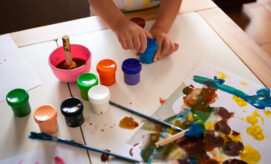Although we do our best to create nurturing and safe environments for the children in our care, many of us have worked with children who find it difficult to feel safe because they struggle with daily fears and worries. Ongoing worry can prevent these children from enjoying play and exploration with their peers. A child is said to suffer from anxiety when fear and worry become big enough to impact the child’s behavior and mood. To support children with anxiety and anxiety-related behaviors, it can be helpful for ECE professionals to recognize signs of anxiety and be aware of specific things we can do in our early learning classrooms to establish a sense of safety for every child in our care.
What Does Anxiety Look Like in Early Childhood?
Because young children often do not have the skills or insight to understand and communicate what they are feeling, emotions related to anxiety often get expressed through a child’s behavior. Some of the more common behaviors you might observe when little ones are experiencing anxiety are described below.
Temper Tantrums & Defiance
For young children who are experiencing distress, it can be common to observe temper tantrums, crying, hitting/biting, or refusal to follow instructions. This display of challenging behavior is often the child’s unconscious attempt to assert some control over their environment in the face of a situation that feels scary or overwhelming. While temper tantrums do not always mean that a child is experiencing anxiety, they can be a signal that the child is communicating distress.
Clinginess
When young children feel unsure about their environment, they often cling to adult caregivers for safety. Staying near the safety of the grown-ups who care for them can help children feel more secure and comfortable. This behavior might be particularly noticeable when the child is experiencing something unfamiliar, such as a new person visiting the classroom.
Difficulty Sleeping
Many of us have experienced the sensation of being kept awake at night by our worries and fears. Children can also experience this type of sleep issue when they are feeling anxious and having worried thoughts. You might observe this in a child who is particularly resistant to transitioning to nap time or who has a tough time getting to a state of relaxation that allows rest.
Avoidance & Unwillingness to Try New Things
When we feel unsafe, it is especially difficult to try something new. As educators, we sometimes observe children who are afraid to take risks, talk to a new friend, or try a new activity. A child might avoid certain activities, tasks, people, or places that cause fear or discomfort, even when we offer reassurance and encouragement.
When Does Anxiety Occur?
Anxiety can occur at any time during the day, depending on the child. A particularly common time to observe anxious behaviors is during drop-off. When children are scared to be away from their parents, it is often referred to as separation anxiety, a phenomenon that is typical during the toddler phase of development. In an article from the Child Mind Institute, psychiatrist Dr. Ron Steingard, explains, “At different stages of development it is normal to have problems around separation, because the world is not safe, and you haven’t learned how to master being away from the people who take care of you. As you develop, and as you begin to master situations and develop skills, it should get easier.”
Transitions between activities can also be a source of anxiety for some children. They might become especially upset about having to clean up or show signs of distress and worry about what could be coming next.
How Can I Support Anxious Little Ones in My Program?
Talk to the Child’s Family
If you notice a change in a child’s behavior, or if you have concerns about their behavior, it is important to talk about this with the child’s parents. A good place to start is by asking family members if they have observed similar behaviors at home, and whether they have found a response that helps their child feel safe. You might also ask the parents if they know of any specific fears that their child experiences so that you can be sensitive to those needs while the child is in your care.
Offer Choices When Possible
Giving children an opportunity to make small choices throughout the day can help them feel a sense of control within the early care environment. These choices could be as simple as holding up two books and asking the child which one they would like to read, or offering both crayons and markers for coloring and asking the child which they prefer.
While these might seem like small things, they can make a big difference in the way that the child views the classroom environment. When an anxious child’s needs and preferences are considered, the child is more likely to feel secure with caregivers and to develop an ongoing sense of trust in the early learning environment.
Focusing on Routine to Establish Safety
Regular routines are crucial in early learning programs. When children know what to expect throughout the day, it helps them to feel safe and secure. In an article for Edutopia, curriculum and instruction specialist, Roisleen Todd writes, “Students feel safe when they know what to expect. They naturally seek out patterns around them and use these patterns to develop guidelines through which they understand the world…consistency provides students with power and control over their environment
Displaying a visual schedule in your classroom helps children quickly refer to the routine throughout the day. Not only does a visual schedule ensure that everyone is on the same page, it also serves as a warm reminder when little ones feel worried about what is coming next.





